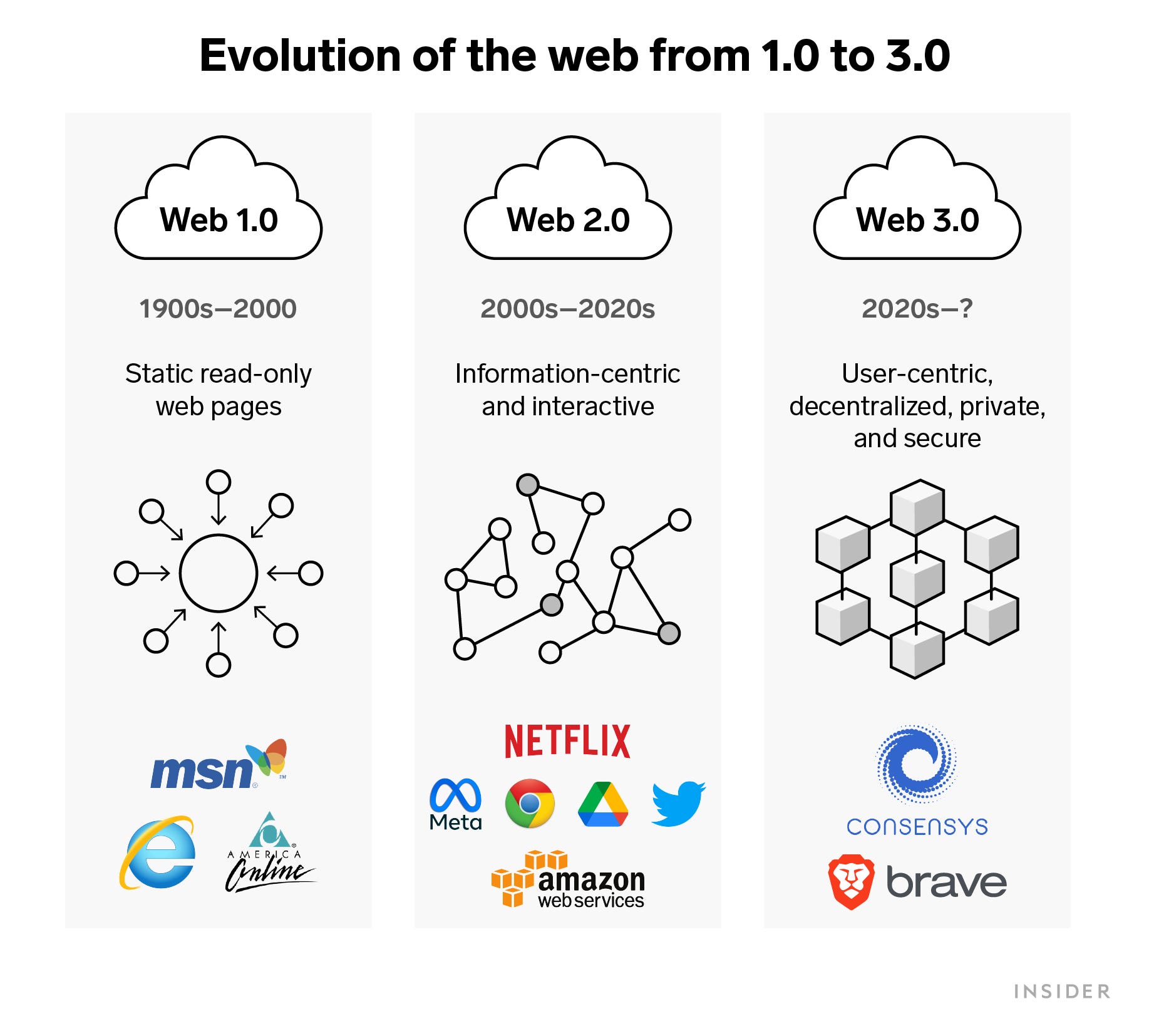10'000 Hours/Getty
- Web3 is a new iteration of the world wide web that hosts decentralized apps that run on blockchain technology.
- Web3 advocates emphasize user privacy and ownership of data.
- Critics of web3 point to its potential to exacerbate class inequality.
If its advocates are to be believed, web3 is freedom, democracy, and ownership — an idealistic version of the web built for users. Theoretically, they're not wrong. Web3 is still in development, a few years away from being usable. Web3 could be this massive overhaul of how we engage with the web and each other. It could just as easily be an overhyped platform for decentralized finance and trading NFTs.
We won't know exactly what web3 will turn out to be for a few years. However, we can take a look at the principles that drive web3 development to piece together an understanding of what web3 might look like.
What is web3?
The term web3, also written out as web 3.0, was originally conceived of in 2014 by computer scientist and ethereum co-creator Gavin Wood in a post on his blog, "Insights into a Modern World." He dubbed it a "post-Snowden" web — Edward Snowden and data privacy had hit headlines the previous year. It is a new, decentralized iteration of the web that runs on blockchain technology.
As we were reexamining our assumptions about the privacy of our personal information and our online activity, Wood writes that "we engineer the system to mathematically enforce our prior assumptions, since no government or organisation [sic] can reasonably be trusted." Essentially, under web3, we know exactly what's happening with our data.
In addition to data privacy, Wood also emphasized online pseudonymity, which means users will connect to the web under pseudonyms instead of their real identities.
Web3 has since taken on new meaning for its advocates. Not only is it a way to manage your data, but web3 is a way to redistribute ownership of the internet. "The whole point of web3 is getting ownership and decision-making away from a small group of people, into the hands of the community. It's very democratic," says Josh Neuroth, head of product at Ankr, a web3 infrastructure company.
How does web3 work?
With our principles in place, we can start examining how certain developmental aspects of web3 are supposed to achieve these goals.
Ownership of data: When you use a platform like Facebook or Youtube, your data is collected, owned, and monetized by these companies. In web3, your data is stored on your crypto wallet. You'll engage with apps and communities on web3 through your wallet, and you'll take your data with you when you log off. Theoretically, since you own this data, you'll also be able to decide if you want to monetize it.
Pseudonymity: Like data ownership, privacy is built into your wallet. On web3, your wallet is your identity, which isn't easily linked to your real identity. So while someone might be able to see the activity of someone's wallet, they won't know that it's your wallet. "My personal information is hidden, but my activities are public," Neuroth says.
There are services out there that work to link users to their crypto wallets used in criminal activity. However, for day-to-day uses, your identity remains obscured.
Democracy: In web3, apps will be run by decentralized autonomous organizations (DAOs). This means that instead of a central administration that makes all the decisions, decisions are made by users who possess governance tokens, which can be obtained by participating in these decentralized apps' upkeep or by purchasing them.
In a traditional company, shareholders vote on changes in the business, which falls on the CEO to implement. In a DAO, token holders get to vote on any proposed changes which are implemented into the DAO's code instantly via a smart contract if the changes are approved. Because DAOs are democratized, everyone has access to the DAO's source code.
Realistically, web3 won't replace web 2.0, at least not in the foreseeable future. "I don't think that web3 has to replace everything in web 2.0. More often than not, it's going to run parallel to web 2.0," Neuroth says. "It just means more options for consumers. If you want to use Facebook, go use Facebook. If you want to use a decentralized system that rewards you for participation, you can go do that."
How is web3 different from previous forms of the web?
To understand what's new about web3, it might be helpful to understand where we're coming from.

Alex Ford/Insider
During the first few years of the world wide web, now called web 1.0, most websites were read-only web pages. This means that pages had no interactivity, they were just meant to be read. Users were purely consumers. The problem with the first version of the web was that creating your own web page and contributing to this version of the web, took a considerable amount of technological know-how.
Web 2.0, the version of the web we're currently using, added functionality for users to "write" as well as read. Web page owners can see metrics on how popular their posts are through clicks and comments. It also gave rise to social media and made content creation accessible to people who wouldn't have the technical know-how in web 1.0.
While these platforms provide access to content creation, they also take our data and use it to figure out what else we might want to consume. Companies also monetize this data by selling it to advertisers. In this version of the web, users are not just consumers, they're also products.
"The internet has been thriving for a long time, but the web has actually been dying," Neuroth says. He says that content on centralized platforms is siloed from each other, which stifles the web. "[Centralized platforms] use the internet, but they're not the web. The web is the open ecosystem."
Criticisms of web3
One of the main criticisms of web3, and the main criticism that former Twitter CEO Jack Dorsey raised in December of 2021, is that the ownership of the aspect will be more one-sided than web3 advocates are letting on.
—jack⚡️ (@jack) December 21, 2021
Since governance tokens can be sold and bought, there's nothing stopping one entity from buying up the available tokens of a given platform, giving them a majority of the decision-making power of a given platform. With this possibility, web3 is only participatory for those who can afford it.
Inequity issues also arise with proof of stake (PoS), web3's validation method. Chandler Song, the chief executive officer of Ankr, says that most of the web3 platforms currently being built are based on proof of stake, a consensus mechanism that validates updates to the blockchain. It is far more energy-efficient than proof of work, the dominant consensus mechanism that utilizes ASIC mining.
However, proof of stake comes with its own baggage. Proof of stake has validators stake cryptocurrency that they already own as collateral when updating new information to the blockchain. The more crypto you stake, the greater chance you have to update the blockchain and earn more currency as a reward. This means that the validators with the most money keep getting richer.
Note: There are currently more than 200 cryptocurrencies that operate using proof of stake, the largest of which is Solana. Ethereum is expected to switch from proof of work to proof of stake in the summer of 2022.
Another problem that web3 poses is that DAO source codes are publicly available, which makes them susceptible to cyber attacks if hackers can exploit weaknesses in the code. In 2016, a decentralized venture fund called TheDAO was hacked. 3.64 million ethereum was stolen, 5% of all ethereum at the time, which caused ethereum to split into ethereum and ethereum classic.
In fact, decentralized finance is a common target for fraudsters. According to Chainalysis, $14 billion went to illicit addresses in 2021, an all-time high and 79% more than last year's $7.8 billion.
Presumably, web3 builders will implement cyber security measures that will target fraud and hacks. In fact, though crypto-related crime is at an all-time high, it is growing at a much slower rate than overall crypto adaptation which was at $15.8 trillion in 2021. We're still witnessing the early stages of whatever web3 might become, so we might find ourselves presuming a lot of things about web3.
"We're still very early on," Neuroth says. "We're still in the MySpace days."
